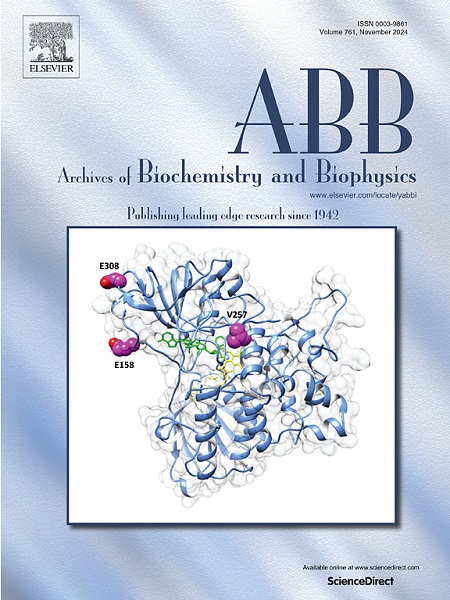婴儿利什曼原虫中 E2 连接酶 LinfUbc13 的分子特征。
IF 3.8
3区 生物学
Q2 BIOCHEMISTRY & MOLECULAR BIOLOGY
引用次数: 0
摘要
UBC13是在墨西哥利什曼原虫中描述的智人泛素结合E2酶的同源物,缺乏该基因的零突变体不能产生,这表明该寄生虫具有基本功能。婴儿利什曼原虫是内脏利什曼病的病原,内脏利什曼病是最严重的疾病类型,如果不治疗可能致命。泛素化过程已被定位为利什曼尼化合物,表明其在寄生虫体内平衡中的重要作用。因此,泛素化过程的分子表征可以更好地了解利什曼病的分子和细胞基础。本研究鉴定了婴儿利什曼原虫的基因LINF_350017900,命名为LinfUBC13,是墨西哥利什曼原虫UBC13和智人UBE2D家族的E2同源基因,与UBE2D1、UBE2D2和UBE2D3具有72-74%的同源性。LinfUbc13含有保守的催化残基,包括Cys86和HPN基序,它们对泛素偶联活性至关重要。结构分析显示,LinfUbc13与人类UBE2D蛋白高度相似,均方根偏差(RMSD)为0.4 Å,表明其功能保守。重组蛋白LinfUbc13表达成功,可接受E1中的泛素,形成硫酯中间体。功能分析表明,LinfUbc13通过人HDM2 E3连接酶将泛素传递给p53,证实了其在泛素化中的作用。亚细胞定位结果表明,LinfUbc13分布在整个寄生细胞质中。这些发现强调了利什曼原虫和智人之间泛素-蛋白酶体系统的保守性,表明LinfUbc13是一种E2酶,在寄生虫发育中起着至关重要的作用。本文章由计算机程序翻译,如有差异,请以英文原文为准。

Molecular characterization of the E2 conjugating enzyme LinfUbc13 in Leishmania infantum
UBC13 is an orthologue of Homo sapiens ubiquitin-conjugation E2 enzymes described in Leishmania mexicana, a null mutant lacking this gene cannot be produced, suggesting essential functions in this parasite. Leishmania infantum is an etiological agent of visceral leishmaniasis, the most severe type of disease that is potentially fatal if untreated. The ubiquitination process has been targeted for leishmanicidal compounds, indicating its essential function in parasite homeostasis. Therefore, the molecular characterization of the ubiquitination process may provide a better understanding of the molecular and cellular basis of leishmaniasis. Here, we characterized the gene LINF_350017900 in Leishmania infantum, which was named LinfUBC13, an E2 orthologue of UBC13 in Leishmania mexicana and the UBE2D family in Homo sapiens, sharing 72–74 % identity with UBE2D1, UBE2D2, and UBE2D3. LinfUbc13 contains conserved catalytic residues, including Cys86 and the HPN motif, which are essential for ubiquitin-conjugating activity. Structural analysis revealed a high similarity between LinfUbc13 and human UBE2D proteins, with a root-mean-square deviation (RMSD) of 0.4 Å, suggesting conserved functions. Recombinant LinfUbc13 was expressed and shown to accept ubiquitin from E1, forming a thioester intermediate. Functional assays demonstrated that LinfUbc13 transfers ubiquitin to p53 through human HDM2 E3 ligase, confirming its role in ubiquitination. Subcellular localization showed that LinfUbc13 was distributed throughout the parasite cytoplasm. These findings highlight the conserved nature of the ubiquitin-proteasome system between Leishmania infantum and Homo sapiens, showing that LinfUbc13 is an E2 enzyme that plays a crucial role in parasitic development.
求助全文
通过发布文献求助,成功后即可免费获取论文全文。
去求助
来源期刊

Archives of biochemistry and biophysics
生物-生化与分子生物学
CiteScore
7.40
自引率
0.00%
发文量
245
审稿时长
26 days
期刊介绍:
Archives of Biochemistry and Biophysics publishes quality original articles and reviews in the developing areas of biochemistry and biophysics.
Research Areas Include:
• Enzyme and protein structure, function, regulation. Folding, turnover, and post-translational processing
• Biological oxidations, free radical reactions, redox signaling, oxygenases, P450 reactions
• Signal transduction, receptors, membrane transport, intracellular signals. Cellular and integrated metabolism.
 求助内容:
求助内容: 应助结果提醒方式:
应助结果提醒方式:


